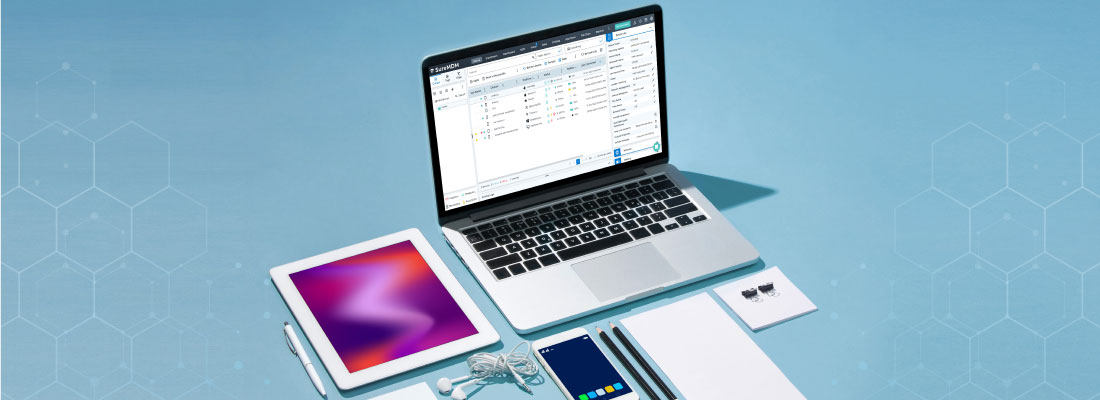Top 8 Mobile Device Management Trends To Look Out For in 2024
jan 09, 2024 | 42Gears Team
In an era dominated by technological innovations and advancements, the way organizations manage their mobile devices is crucial for ensuring efficiency, security, and seamless operations. Mobile Device Management (MDM) has been a key player in this domain, and as we step into 2024, the landscape is evolving rapidly. According to a recent report, the MDM market share is valued at US $7.2 billion in 2022 and is likely to reach US $40.8 billion by 2032.
In this blog, we'll explore the emerging trends in MDM that are shaping the way businesses approach mobile device security and management.
1. Endpoint Diversity Management
With the proliferation of diverse mobile devices, including PCs, smartphones, tablets, wearables, and IoT devices, MDM solutions are adapting to manage this increasing endpoint diversity. In 2024, MDM platforms are expected to be equipped to handle not only traditional devices but also emerging technologies like AR/VR and peripherals, ensuring a comprehensive approach to endpoint management.
This trend is particularly relevant as the boundaries between personal and professional devices blur. MDM solutions like SureMDM now offer greater flexibility, allowing organizations to manage and secure a wide range of endpoints, irrespective of the operating system or form factor. SureMDM supports a wide variety of operating systems, and has recently extended its existing support on Android, ChromeOS and Apple TV.
2. Increased adoption of BYOD
The surge in Bring Your Own Device (BYOD) policies within organizations underscores the growing preference for the flexibility and cost-effectiveness offered by employee-owned devices. MDM solutions, exemplified by platforms like SureMDM, are pivotal in adapting to this trend. They provide organizations with the necessary tools for a seamless BYOD approach, offering granular control over both personal and corporate data on shared devices. Robust containerization and data separation protocols ensure the security and privacy of sensitive information, addressing the challenges associated with the convergence of personal and professional data.
In response to the BYOD paradigm, MDM solutions are evolving to integrate with Identity and Access Management (IAM) systems. The seamless integration of IAM systems into MDM solutions enhances overall security, providing organizations with a unified mechanism to manage user identities and permissions in the context of BYOD. As companies embrace BYOD, MDM solutions like SureMDM play a crucial role in facilitating a secure transition, ensuring operational flexibility while maintaining stringent controls over data security and access management.
3. Enhanced Security Protocols
As cyber threats continue to evolve, the need for robust security measures for MDM solutions becomes paramount. In 2024, we anticipate to witness a significant shift towards enhanced security protocols embedded within MDM platforms. This includes advanced encryption techniques, like data encryption - BitLocker, Integration with MTD vendors, biometric authentication, and real-time threat detection mechanisms.
MDM providers, like 42Gears, are increasingly focusing on proactive measures to safeguard sensitive data and prevent unauthorized access. The integration of artificial intelligence and machine learning algorithms allows MDM systems to adapt and respond to emerging threats in real-time, providing organizations with a more resilient defense against cyberattacks.
4. Zero Trust Architecture
The concept of Zero Trust Architecture has gained traction in recent years, and its influence on MDM is set to grow in 2024. Zero Trust emphasizes the idea that organizations should not automatically trust any entity, inside or outside their perimeter, and must verify anything and everything trying to connect to their systems before granting access.
MDM solutions, like SureMDM, enable businesses to adopt a Zero Trust approach that requires users and devices to authenticate themselves continuously, even after gaining initial access. This model enhances security by minimizing the potential damage caused by a compromised device, ensuring that ongoing verification remains a priority throughout the device's lifecycle.
5. Cloud-Based MDM Solutions
The pervasive shift towards cloud-based solutions continues to shape the IT landscape, and MDM is no exception. In 2024, organizations are showing a growing inclination towards cloud-based MDM solutions, drawn to their scalability, flexibility, and simplified management.
Embracing cloud-based MDM provides organizations with centralized control and real-time updates, effectively alleviating the administrative burden on IT teams. This aligns seamlessly with the prevalent remote and hybrid work models, granting organizations the agility to efficiently manage devices and enforce security policies regardless of users' location
SureMDM goes the extra mile by offering dedicated deployments for cloud setups, ensuring tailored solutions that cater specifically to the unique requirements of cloud-based MDM. This approach enhances the adaptability of SureMDM, allowing organizations to leverage the benefits of cloud infrastructure without compromising on security or customization. Whether an organization opts for an on-premises deployment or embraces the cloud, SureMDM stands as a reliable MDM solution platform that’s committed to meeting the evolving needs of modern enterprises.
6. User-Centric Management
Recognizing the importance of user experience, MDM solutions are evolving towards a more user-centric approach. In 2024, the focus is not just on securing devices but also on ensuring that users can seamlessly integrate their devices into their workflow without compromising productivity.
The latest wave of user-centric MDM platforms places a premium on striking a harmonious balance between robust security measures and intuitive usability. These platforms empower employees with the freedom to leverage their preferred devices while still adhering to stringent organizational security policies. This evolution highlights a profound understanding that providing users with the right tools not only fortifies security but also catalyzes increased efficiency and overall satisfaction.
Furthermore, this user-centric approach extends to the enhancement of user interfaces (UI) and the streamlining of workflows. In 2024, MDM solutions are expected to prioritize user-friendly interfaces, ensuring that employees can navigate security settings and protocols with ease. Easy workflows will become a hallmark of advanced MDM platforms, promoting a seamless and intuitive integration of devices into daily tasks. This comprehensive approach to user experience reaffirms the commitment to both security and user satisfaction in the ever-evolving landscape of mobile device management.
7. Automation and AI-Driven Insights
Automation stands out as a central theme in contemporary IT management, and MDM is actively embracing this trend. Looking ahead to 2024, MDM solutions are set to elevate their functionality by integrating advanced automation features that go beyond streamlining routine tasks like device provisioning, updates, and troubleshooting. One notable addition to this landscape is the implementation of self-healing capabilities, where MDM platforms can autonomously identify and rectify issues, further reducing the workload on IT teams and significantly mitigating the risk of human error.
In tandem with this, the infusion of AI-driven insights is revolutionizing the paradigm of device management. Predictive analytics and machine learning algorithms leverage data gleaned from device usage patterns, security incidents, and user behavior. This data is then harnessed to provide proactive recommendations and insights, empowering organizations to anticipate and address potential issues before they escalate. This transformative integration enables informed decision-making, allowing organizations to stay a step ahead in managing their devices effectively.
8. Compliance and Privacy Concerns
As data protection regulations become more stringent worldwide, MDM solutions are adapting to address compliance and privacy concerns. In 2024, MDM platforms will be equipped with features that help organizations adhere to data protection laws and industry-specific regulations.
This includes enhanced privacy controls, data encryption, and tools that facilitate compliance reporting. MDM providers are actively collaborating with legal and compliance experts to ensure their solutions align with the ever-evolving regulatory landscape.
SureMDM stands out by actively supporting HIPAA compliance, specifically tailored for healthcare organizations to secure sensitive patient data. Beyond regulatory requirements, MDM solutions like SureMDM enhance privacy controls, implement robust data encryption, and streamline compliance reporting tools.
The benefits of this evolution extend beyond regulatory adherence, and end users can experience heightened data security and privacy protection. With SureMDM and similar platforms, individuals and organizations confidently integrate these technologies into their workflows, knowing their data is safeguarded with the utmost diligence. As MDM solutions evolve to address compliance and privacy concerns, end users are expected to enjoy a seamless and secure digital experience.
Conclusion
The mobile device management landscape in 2024 is set for a significant transformation, characterized by a convergence of security, flexibility, and an emphasis on user-centricity. Organizations increasingly recognize the pivotal role MDM plays in safeguarding digital assets, especially in the ever-evolving dynamics of modern work environments.
In the pursuit of comprehensive security, MDM solutions now deploy advanced technologies, including AI, to fortify existing protocols against emerging threats. This intelligent integration ensures a proactive defense, adapting to evolving cyber risks. The incorporation of Zero Trust Architecture represents a milestone, promoting a holistic and continuous verification approach aligned seamlessly with MDM principles. User-centric management remains fundamental, with MDM platforms leveraging insights to customize and optimize user experiences, fostering productivity and intuitive interactions with mobile devices. As businesses embrace mobility and remote work, MDM's role in delivering a secure and seamless mobile experience becomes increasingly crucial, positioning it as a linchpin in the dynamic digital landscape of the future.
Are you looking for a reliable MDM solution?
Subscribe for our free newsletter








